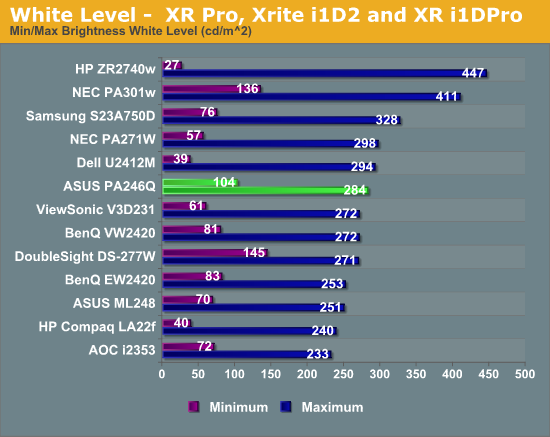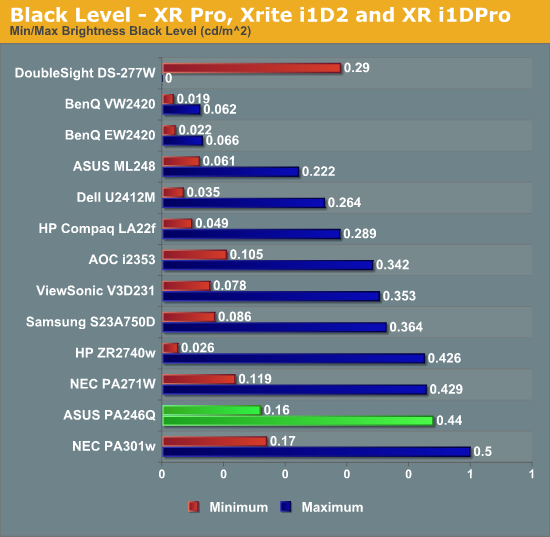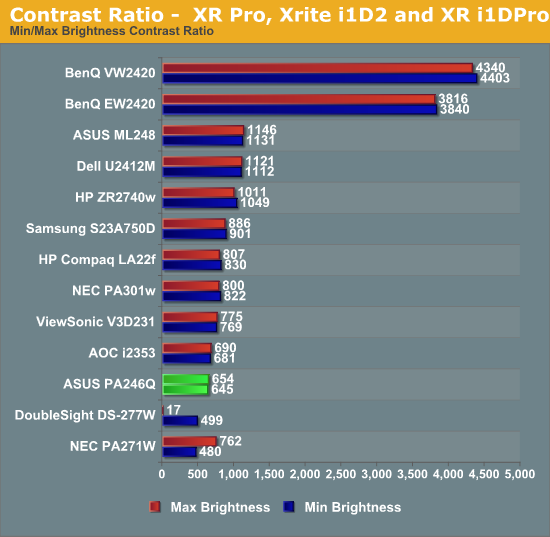ASUS PA246Q 24" ProArt Monitor: No Adjustments Needed?
by Chris Heinonen on July 2, 2012 1:30 PM ESTASUS PA246Q - Brightness and Contrast Ratios
As important as color accuracy is, everything starts with the dynamic range a display offers, which is based on its contrast ratio and brightness. If you have perfect colors but very little dynamic range, you won’t be able to distinguish light from dark, or have shadows or highlights that have any depth to them. Cranked up to the maximum with a calibrated screen, I obtained 284 nits of light from the PA246Q, and at the minimum setting I managed 104 nits. Since this is from a calibrated setting, the maximum output is reduced. You can push all of your settings to the maximum and get a brighter image from the PA246Q but it will be excessively green tinted as green has the highest light output of the primary colors.

Even with it only producing 284 nits, this is more than enough for any work environment it will see in the real world. The minimum output is a little higher than I would prefer, as some people work as low as 80 or 100 nits for print work, but it isn’t awful. IPS traditionally doesn't excel in black levels compared to VA panels, and the PA246Q doesn’t have a dynamic LED lighting system or any other technology to try to improve this. Because of this we have a really high black level on the PA246Q, with the lowest value I could obtain being 0.16 nits. I don’t use a 100% black screen for these measurements as that allows some panels to totally turn off the backlight and it’s not applicable to any real-world use, but I have a small amount of light at the edges of the screen for testing. Because of this you can potentially coax better numbers out of some displays than whay I report, but I don’t feel they have any real world application.

With this higher black level, we manage to get a contrast ratio that is pretty ordinary at best. Coming in at around 650:1 this comes in close to some of the inexpensive TN displays we've reviewed, along with the cheaper IPS panels that have been in the lab. Other models are able to pull out 1000:1 or better, which is what I would like to see out of a high-end panel now. Most of these panels aren’t using a wide spectrum backlight that can support the AdobeRGB colorspace, and that support might be what is causing the higher black levels and lower contrast ratio, so it is something users would have to consider when evaluating the PA246Q for their use.

Overall the brightness numbers for the PA246Q are good, but the black level and therefore contrast ratio numbers leave a little more to be desired from a display at this price point.










52 Comments
View All Comments
cheinonen - Monday, July 2, 2012 - link
The PA246Q had already been requested, and arrived, when the PA248Q was announced. It also an sRGB monitor as opposed to AdobeRGB, so a better comparison for it might be the Dell U2412M, whereas the PQ246Q competes with the Dell U2410. Using such a similar model number is annoying, but really they're complementary products and not competitive ones.Leyawiin - Monday, July 2, 2012 - link
Yep - its coming to market late this month (and I think I'm going to pop for one at that price).Spoogie - Monday, July 2, 2012 - link
There are serious quality control issues with this model. On my second one in six weeks. 1) humming noise, 2) flickering, and 3) goes blank randomly for 1-3 seconds. The first one did both one and two, the second one has all three problems.I'd return it if I wasn't past the 30-day return window.
aranyagag - Tuesday, December 11, 2012 - link
mine was perfectDevo2007 - Monday, July 2, 2012 - link
It appears you are missing the results for this monitor in the "Calibrated for Print Average Delta E" graph..cheinonen - Monday, July 2, 2012 - link
Sorry about that, fixed it now, not sure how it got left out.funkforce - Monday, July 2, 2012 - link
Fantastic review! Even better than many on sites dedicated to TFT-reviews only.I hope there are a lot more of these to come and I would really like to see more on:
What progress has been made in the last years and what are the top monitors in each field/technology today for non-pro users?
(PVA/MVA/AMVA vs. IPS/eIPS vs. TN technology/best in class.)
What would be the best non-TN panel for gaming today?
Does performance differ a lot on the HDMI and DVI-output on the same panel? (In cases where both exists)
Would it possible to manufacture a LED, 120hz, IPS/VA, 2560x1440, with minimum input lag, near accurate colors and good blacks in the near future?
Will OLED make this a reality?
On most comparison sites for shoppers there are a lot of customer reviews that are mentioning problem with backlight bleeding on most IPS panels.
It would be awesome if you could get an extra retail sample of every monitor you review to see if there's a big difference between to identically named panels.
(I know a guy that bought two would be identical LG screens from the same store where one was manufactured in China and the other in Poland and they differed a lot).
Although I understand if it would be an unreasonable wish.
I just bought a LG IPS236V and it has some backlight bleeding in both the lower left and right corner. It has a gamma setting that goes from 1.8-2.6 where the default 2.2 and above unfortunately only emphasizes the problem. Only the very bright setting of 1.8-2.0 (lower is brighter) result in very little bleeding but blacks are not so dark as one would wish.
It has several options greyed out, like black level and white balance no matter if you use an HDMI or DVI Cable. Is this normal and do you see it on lot of screens during your reiviews?
Many thanks in advance!
funkforce - Monday, July 2, 2012 - link
You can disregard my last question about the white balance and black level. Totally missed that page in the manual about it only being available on DSUB and HDMI.rickon66 - Monday, July 2, 2012 - link
I applaud them for building a computer monitor 16:10 and not a TV set 16:9. Thank You ASUS!Any monitor larger than 23" @1080p = FAIL!
Olaf van der Spek - Monday, July 2, 2012 - link
Right. 4:3 @ 1920 x 1440 or 2048 x 1536 would be even better. :p